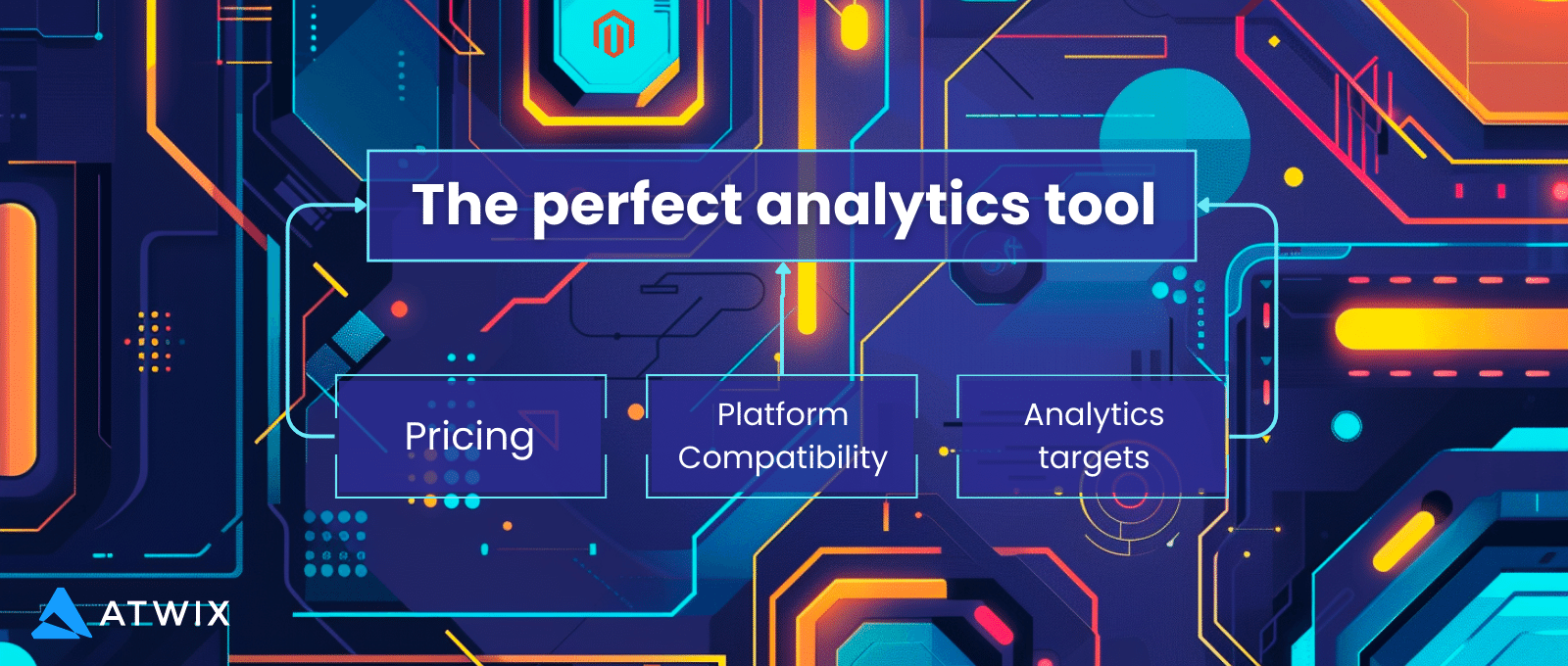eCommerce analytics enables companies to better understand their customers and the market itself. Through valuable, data-driven insights, you can predict supply and demand. Additionally, it helps you define the strong and weak points of your business. Analytics also provides a deeper look into your competitors, providing a valuable advantage.
In this guide, we will discuss the current advancements in analytics and the best tools for the task. We’ll cover the starting steps and the specifics of analytics use in eCommerce. Based uponAtwix’s decades of experience, we’ll share insider tips and illustrate them with our eCommerce analytics examples.
eCommerce Trends for Analytics in 2024
2024 will likely bring exciting changes for the data analytics field, as companies use innovative technologies and approaches to gain insight into consumer behavior and preferences. This is includes:
- Predictive analytics
- Voice analytics
- Real-time analytics
- Customer data platforms
Predictive Analytics
The ability to use eCommerce analytics with automated processing to forecast demand is game-changing for boosting sales. Being able to accurately forecast what the customer will want also means being able to sway it. This provides an opportunity to market your goods more effectively and to structure logistics optimally.
Voice Analytics
According to Insider Intelligence, voice assistants are on an upward trend, with Gen Z leading in using this technology. Couple this with chatbots, and the data gathered from these two sources could be invaluable. Businesses can analyze it to determine if similar shopping helpers will boost sales for their brand. It also makes UX improvements easier, as you’ll be able to know customers’ pain points firsthand.
Real-Time Analytics
By analyzing data the moment it’s generated, a business can make a quick decision that results in a sale. This includes things like dynamic pricing, personalized recommendations, and even giving each visitor personaized push notifications. Capitalize on abandoned carts instantly and try to regain a sale.
Customer Data Platforms
Platforms that help aggregate and process data in one spot make setting up eCommerce tracking easier. Solutions such as Adobe’s CDP or an Enterprise Data Warehouse enable omnichannel eCommerce with consolidated customer profiles. This helps you know your audience with pinpoint precision, as well as analyze each buyers’s spending potential. Thus, you can quickly calculate potential ROI for a new marketing campaign.
eCommerce Analytics Types and Key Metrics
So, what metrics do you need to collect to make your analytics suite effective? This list depends on the data you can glean from the metric, as well as how to apply it. We recommend the following analytics:
- Audience
- Acquisition
- Behavior
- Conversions
- Paid Marketing Activities

Audience
With this, we can determine the demographic of people who use the store. This helps understand where to place ads, what those ads should look like, etc. Plus, based on audience analytics, you glean what offers may be more lucrative. Some segments prefer free shipping, others — discounts. With Audience Metrics alignment of segments with the right offers becomes easy.r.
Acquisition
Track how buyers reach your store and what helped steer them toward your product. Acquisition data explains which partnered sites or ad platforms are effective for your business, as well as shows blind spots in your area of reach. With them, you can expand or narrow the number of marketing campaigns you do to make acquisitions abundant.
Behavior
This type of eCommerce web analytics guides your decisions on UI and UX changes. Knowing what shoppers do when they’re in your store helps guide them to purchases. You’ll see which pages get the most attention, as well as which products are being viewed and bought most often. As a result, you will streamline the customer experience, highlighting the right items to sell.
Conversions
Finding the precise point when a site visitor becomes a customer helps you repeat that process for others. You can determine the factors for cart abandonment, and boost eCommerce platform performance by knowing what the buyer wants — and giving it to them. From discovering the weak points in your store, to analyzing design strengths, conversion optimization brings value.
Paid Marketing
When you invest in an ad campaign, it’s crucial to understand whether that money is making its way back to you in the form of new purchases. Analyzing the number of views, clicks, and conversions from each of your marketing activities helps see the ROI. It’s a way to lower expenses by applying your marketing in a more precise way.
7 Steps to Get Started with Analytics
Now that we know what to track, let’s discuss how to make analytics for eCommerce work for you. The process is quite straightforward, but we’ll break it down into a step-by-step guide to make things even easier.
Unify Data Sources
Customer data platforms an up-and-coming trend for 2024. Use every channel in a single, unified space to track metrics and understand your shoppers, regardless of where the data is pouring in from. This helps make sure everything is analyzed, as well as simplifies the process of feeding those eCommerce data analytics into relevant tools.
Define KPIs
Analysis without a goal is ineffective; therefore, define the objectives you want your store to achieve. From the number of conversions, to view counts on marketing campaigns, set the bar for yourself and strive to reach it.
Understand Your Customers
Use initial data insights to gain a deeper understanding of your customers. Every demographic has its quirks, and your job is to build familiarity into your analysis. If you know that your Gen Z customers are more likely to shop with their phones, but that’s not happening — you can find the reason why. It helps deal away with any uncertainty that regular analysis can’t cover.
Configure Proper Website Tracking
Make sure you’re running Google Analytics and make sure it’s GA4, with best-practice use of Google Tag Manager — the latest iteration. You need to be gathering a lot of data, such as:
- Average spending
- Conversion rate
- Time spent before purchase
- Product popularity.
Without this being set up, you won’t have anything to analyze. Speaking of which…
Analyze Your Data
To ensure your eCommerce analytics results in actionable insights, you will need to plug the data into the right tool and make sure that dataset is clean. That means removing duplicates, merging certain subsets, and bringing related categories to the same formatting. With that all done, you can analyze things properly.
Summarize Findings
Compile the results into point-by-point reports that can be implemented by your team. The most effective way to structure it is by showing off the customer journey. Along that journey, you present the metrics and highlight areas to improve. Perhaps the customer takes too long to open the relevant category or the ad you placed isn’t effective enough — with that information, the team can implement fixes.
Make the Most of Tools
A lot of data processing and compilation can be automated, freeing you to focus on the more advanced efforts. Things like cleaning the dataset can be done with practically no human oversight, speeding up the path from data collection to improved reports. We strongly recommend using software that will make things easier for you.
Choosing the Right Analytics Tools for Your eCommerce Business
Since we just talked about analytics tools, it only makes sense to provide you with some of the top ones available now. Once you’ve set up eCommerce analytics and need to work with the data, these will be life savers. While this list is helpful, remember to also consider the following when choosing your tools:
- Capability to measure the analytics targets
- Pricing to fit the budget
- Compatibility with the platform

Adobe Analytics
For an enterprise grade tool that can knit web analytics with marketing analytics and more to deliver actionable insights, look to Adobe Analytics. From SEM ROI metrics, to Predictive AI, this tool delivers the metrics needed to boost KPIs with the right business decisions. While this works great with Adobe Commerce, that is not a requirement. It also integrates smoothly with other Adobe suite tools like Adobe Target.
Glassbox
This tool helps you see every step your customer takes on your website. One of its best features, and the reason why we place Glassbox on our list, is the session replay. It visualizes the shopper journey and lets you “live” through their shopping session. This is great because you can spot UX flaws that didn’t impact that customer but could bother others.This approach lets you identify and address problems early, before they cause any damage.
Woopra
Yet another trend from our list of up-and-comers is already available to those willing to experiment. Woopra enables real-time analytics, as well as segments your audience to make insights more precise. Plus, it has marketing automation, making promoting your brand and products easier.
Glew
The reason why we like Glew is its strong visualization offerings. Spotting trends and patterns is much easier when you can see the data clearly and this is what Glew excels at. It also has strong segmentation algorithms to make sure you’re applying any insights with high precision.
Setting Up Analytics for eCommerce Success
Before going into the last part of our guide, we want to give a little more detail on how to actually set up analytics. This will let you understand whether you want to do it all yourself or request the help of professionals. To keep things simple, we’ll use the example of integrating Google Analytics with Magento.
Your first step is to open the Magento dashboard and go to Stores > Configuration. There, you need to hit Sales and choose Google API. At that point, you need to add your Analytics ID. To find that, log into your GA account and go to the Admin section. Find the Property Settings section and “Data collection and modification”, then click to expand it.
There, you click on Data streams and your relevant data stream. Scroll all the way to the bottom and click on “Configure tag settings” in the Google tag section. There, you will see a tag that starts with either G- or AW-. That’s your ID, which you need to insert in the platform dashboard. With that, your data stream is set up.
Best Practices from Atwix for eCommerce Analytics
We’ve explored eCommerce analytics use cases and how to start leveraging analytics for your benefit. Now, we will round out this guide with examples of Atwix’s own cases to give you an industry insider perspective on analytics.
While a lot of our cases involve helping Atwix clients in choosing the right eCommerce platform, some businesses come in knowing exactly what they want. This was the case with Coyuchi, a brand that requested in-depth analytics and performance optimization. On the analytics side, we set up Google Analytics with a tag manager, as well as data collection from Facebook and Pinterest Pixel.
Next is MeasureUp, a case that shows the importance of not just analytics but in-depth work with the processed data. Despite the company using data from GA, Power BI, and IT reports, they were still in need of deeper insights. This is where Atwix was recruited, finding action items to refine MeasureUp’s website. While many companies may try to do it all themselves, the improved performance of the MeasureUp store clearly shows the value of vendors like Atwix. Conducting a Magento Performance Audit helped Atwix identify critical areas for improvement, leading to significant enhancements in the MeasureUp store’s performance and user experience.
Conclusion
As you now know, analytics has the power to rejuvenate your business and help you understand your customers better. However, it only achieves its full potential when you use the right tools and set up the data collection and data processing optimally. We gave some experience-based tips on how to do that, as well as explained what to look for when gathering metrics.
That said, it’s always easier to get the most out of analytics for eCommerce when you have a professional team to rely on. Atwix has been in the eCommerce industry since 2006, delivering custom development and design for companies that want the best. If you’re aiming to establish analytics that will enhance your sales, we are at your service.
Start your journey to success with analytics and Atwix today. Contact us for a consultation.
Frequently Asked Questions
Got some questions? We’re here to answer. If you don’t see your question here, drop us a line with out Contact form.
Can analytics help improve conversion rates and customer retention for an online business?
Yes, the main intent of setting up analytics for eCommerce is to understand your customer better. This allows you to cater to their interests and wants, raising the conversion rate. A buyeris more likely to return to a business when they feel like their experience matches their expectations, and analytics help refine that experience.
What are some common challenges when implementing analytics, and how can they be overcome?
The core challenge is using the processed data effectively. You’ll be seeing a lot of information and there’s always a temptation to retool your approach based on that. However, it’s often better to make smaller changes to your strategy and feel out the response from your customer base.
How do I measure the ROI of implementing analytics tools and strategies?
You need to be looking at the effect that analytics is having on your business. It should boost revenue, potentially reduce costs, and optimize any market research you undertake. These are just three potential metrics to quickly reveal the returns you get from high-quality data.
Why does it matter which analytics tool we use?
Different tools collect different data, with the resulting analytics changing correspondingly. If you want to have an advantage over your competitors, it’s important not to settle for the same tools everyone uses. Instead, a more powerful and in-depth eCommerce analytics package will give you an edge in the market.
